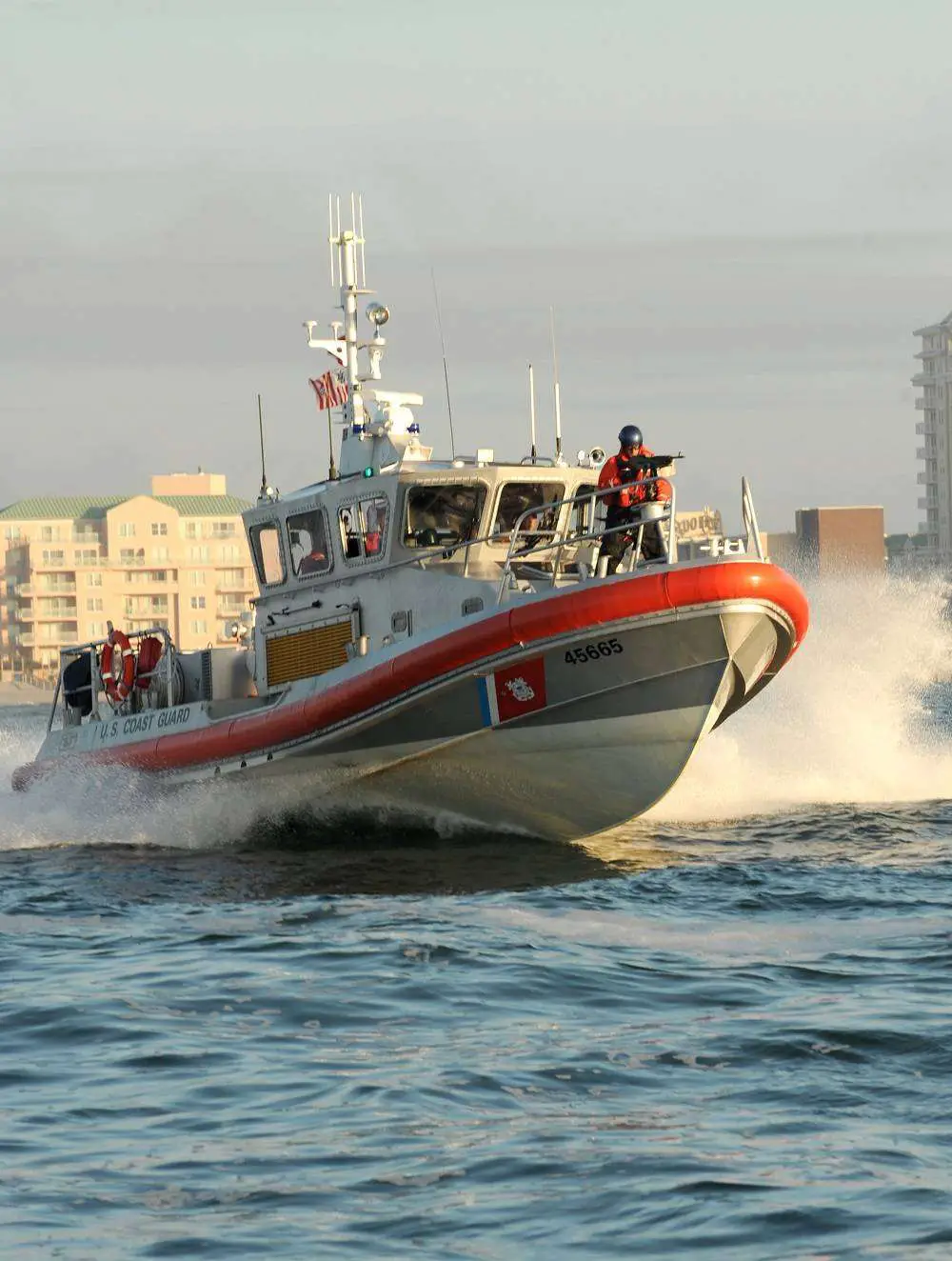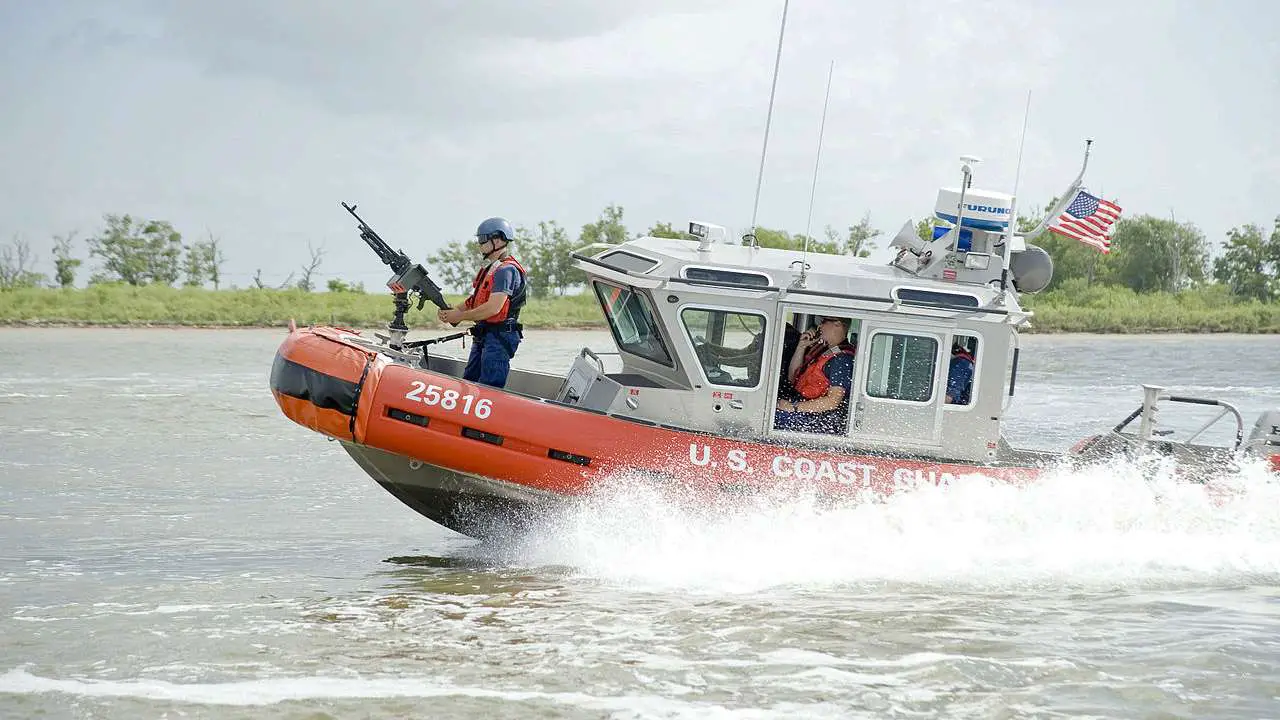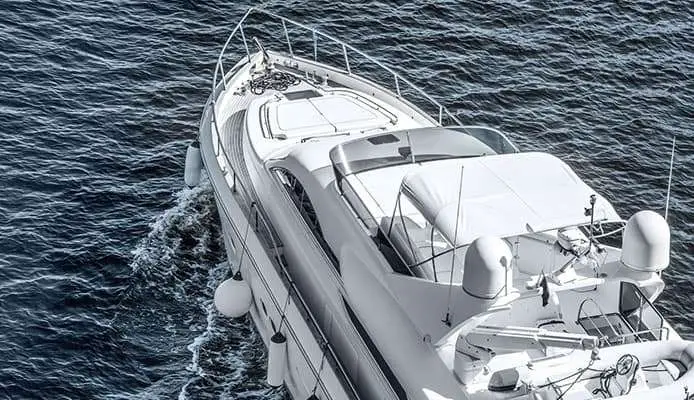Nj Boating Carriage Requirements
Motorboats Less Than 16 Feet In Length
- Personal Flotation Device: One Type I, II, III, or V Coast Guard approved personal flotation device must be carried for each person on board. They must be readily accessible and of an appropriate size for the intended wearer.
- Fire Extinguisher: One Type B-I Coast Guard approved fire extinguisher must be carried when no fixed fire extinguishing system is installed in machinery spaces. Extinguishers are not required for outboard motorboats less than 26 feet in length and of open construction. No portable extinguishers are required if an approved, fixed fire extinguishing system is installed in machinery spaces.
- Backfire Flame Arrestor: A Coast Guard approved backfire flame arrestor is required for inboard gasoline motors which are not exposed to the atmosphere above the level of the gunwale. Muffling System: An effective muffling system is required for the exhaust of each internal combustion engine. Unmodified outboards usually meet legal requirements.
| Top
Motorboats 16 Feet To Less Than 26 Feet
| Top
Motorboats 26 Feet To Less Than 40 Feet
| Top
Motorboats 40 Feet To 65 Feet
| Top
Sailboats And Manually Propelled Vessels
Personal Flotation Devices
The minimum requirements are:
| Top
Ventilation Systems
| Top
Backfire Flame Control Device
| Top
| Top
Oily Waste Discharge Placard
| Top
| Top
Waste Management Plan
| Top
Navigation Lights – Inland And International
At What Point Do I Need A Captains License
If you own a boat or spend a lot of time out on the ocean, youve probably come across the term captains license. You may even be wondering if you need one to operate your own personal vessel. If youre taking your boat out leisurely on the weekends with family and friends, then you dont need a captains license, however if you are carrying passengers for hire , youll definitely need to attain one.
A captains license is similar to a drivers license, only for boats. There are a number of licenses available, based on the type and size of the vessel being operated but there are two main types that are issued by the United States Coast Guard :
Inland Visual Distress Signals
If you ever get stuck on land in the middle of nowhere after something went wrong with your boat, you will still need to use visual distress signals to be saved. Along with flairs and all other visual distress signals, having a lighter to start a fire or smooth glass to make reflections may be useful if youre on land.
Also Check: Boat Rental Grand Lake Colorado
Collisions Accidents Casualties And Liability
The operator/owner of a vessel used for recreational purposes is required to file a report in writing whenever an accident results in: loss of life or disappearance from a vessel an injury which requires medical treatment beyond first aid or property damage in excess of $2,000 or complete loss of the vessel. Reports in death and injury cases must be submitted within 48 hours. Reports in other cases must be submitted within five days. Reports must be submitted to the reporting authority in the state where the accident occurred. For more information contact the Department.
Safety Requirements For Recreational Boats

As the owner of a recreational boat, you are required to carry aboard your vessel a minimum of safety equipment. Most of us go about our boating experience giving very little thought to the possibility of misfortune, and rarely are our experiences anything but positive. But remember the motto: Be prepared!
As vessel owners we are subject to the requirements placed upon us by our state and federal governments regarding the operation of, and the equipment we carry on, our boats. Some might feel this is a case of Big Brother being involved more than they would like but the reality is that safety items we are required to carry on board are usually only the minimum. Sometimes when a tragic situation does occur, vessel operators wish they had gone beyond the minimum. These requirements are for our own good.
So, what exactly are we required to carry on board? Certainly, the size and type of vessel has some impact on that decision. Here is the list, made as convenient as possible.
Read Also: Is Boat Insurance Required In Florida
Note: The Us Coast Guard’s Free Pamphlet Federal Requirements For Recreational Boats Gives More Complete Details On How Many And What Types Of Equipment You Must Have Aboard Your Boat Call The Coast Guard 800
Boats Less Than 16ft
Personal Floatation Devices
Recreational boats must carry Coast Guard approved Personal Flotation Devices, in good and serviceable condition, and of appropriate size for the intended user. Wearable PFDs must be readily accessible, not stowed in bags, locked or closed compartments or have other gear stowed on top of them. Throwable devices must be immediately available for use. There must be one Type I, II, III, or V PFD for each person on board or being towed on water skis, etc., PLUS one Type IV throwable device. Throwable, Type IV PFDs may no longer be substituted for wearable types on boats less than 16 feet. State laws on mandatory PFD wear may vary.
Fire Extinguishers
At least one B-1 type Coast Guard-approved hand portable fire extinguisher. Not required on outboard motorboats less than 26 feet long and not carrying passengers for hire if the construction of such motorboats will not permit the entrapment of explosive or flammable gases or vapors, and if fuel tanks are not permanently installed.
Visual Distress Signals
Must carry approved visual distress signals for nighttime use.
Sound Producing Device
Every vessel less than 39.4 feet long must carry an efficient sound-producing device such as a whistle or horn.
Ventilation
Ventilation
Backfire Flame Arrestor
Boats 16ft to Less Than 26ft
Personal Floatation Devices
Fire Extinguishers
Visual Distress Signals
Sound Producing Device
Ventilation
Ventilation
Backfire Flame Arrestor
Fire Extinguishers
Check Your Boat Safety Equipment Regularly
Never tamper with a safety device. Check your equipment regularly to make sure it is always in good working condition. If in doubt, it is better to have it repaired or replaced. As good as the devices are, they are only as good as knowing how to use them effectively.
Its also smart to keep your boat clean and organized. This is the single best way to avoid unnecessary trip hazards. It is best to thoroughly understand your boat by knowing how it operates and handles on the water. Always pay attention to your surroundings and other boaters. You are the primary key to keeping you, your family, and others safe aboard your vessel.
Also Check: Does Chase Do Boat Loans
Coast Guard Boat Requirements
If youve ever been pulled over by the coast guard, you know that there are many different requirements that they have because you were probably missing one. In this article, not only will I go over all of these safety requirements by the U.S. Coast Guard, but also more safety equipment that I recommend having at all times.
So below is the required safety checklist that every boater needs from the U.S. Coast Guard boat inspection checklist . Click on the range of sizes your boat falls under and all the requirements are there.
Use the table of contacts to navigate to your boat size requirements.
Who Must Register Their Boats
Owners of any watercraft propelled by motors must register their vessels with the North Dakota Game and Fish Department. The vessel owner will receive a Watercraft Registration certificate that must be available on the vessel when in operation.
Current boat owners are encouraged to renew their registration online at the Game and Fish website, gf.nd.gov.
Registration of new boats, or transfer of boat ownership, is available online. Anyone buying a new boat from a dealer, or from a private individual, must complete the registration online.
Don’t Miss: How To Clean Boat Carpet Mold
Outboard Motor Serial Numbers
No outboard motor manufactured after January 1, 1980, shall be sold or offered for commercial sale by a dealer in this state unless the motor has permanently engraved thereon by the manufacturer an identifying serial number. The serial mark shall be of a permanent nature so as to prevent or discourage the removal, defacing, alteration or destruction thereof.
No person may possess, repair, or sell an outboard motor, acquired after January 1, 1980, from which the serial number has been removed.
Throwable Pfds That Double As Rescue Slings
Hoisting overboard crew members back on board is challenging even in the best conditions. Extensive testing of crew overboard recovery gear in San Francisco Bay produced a clear consensus that one product, the Lifesling, is a great device for getting a person back to the boat and aboard safely. The Lifesling2 includes a flotation collar with 125′ of floating retrieving line. It can be towed to the victim so they do not need to swim after it and then used as a lifting sling . The Lifesling Inflatable combines these capabilities with the compactness and throwability of a rescue throw rope bag, inflating instantly on hitting the water.
Read Also: How To Keep Birds Off Boat
Us Coast Guard Requirements: Boat Safety Equipment
All vessels, regardless of length, are required to comply with federal and state laws regarding boating safety equipment. The specific equipment needed varies depending on the length of the boat. However, this article focuses on providing the minimum federal boat safety equipment requirements as directed and enforced by the US Coast Guard for vessels under 40 feet in length. Some states and localities have additional boat safety requirements, so always stay abreast of any mandates specific to your area.
When accidents happen while boating, it can take longer for help to arrive, the only things you have to stay safe are the items you carry within your boat until it does.
Table 1: At-a-Glance US Coast Guard Boat Safety Equipment Requirements for vessels less than 40 ft. Click to enlarge.
Termination Of Unsafe Use

Any law enforcement officer who observes a vessel being used without sufficient lifesaving or fire fighting devices or in an overloaded or other unsafe condition as defined in Department regulations and in his or her judgment such use creates an especially hazardous condition, may direct the operator to take whatever immediate and reasonable steps would be necessary for the safety of those aboard the vessel, including directing the operator to return to mooring and to remain there until the situation creating the hazard is corrected or ended. For the purpose of this provision, an unsafe condition includes, but is not limited to the following:
Read Also: Does Boat Insurance Cover Theft
Federal Recreational Boating Guidelines
Recreational vessels operating in Massachusetts waters must meet Federal regulations for recreational boats AS WELL AS Massachusetts specific requirements.
Below is a link to the Federal requirements:
Key Items for Federal requirements in addition to Massachusetts list above:
Boats over 26 – 40 feet LOA:
Boats over 40 feet LOA:
Thank You For Keeping New Jersey’s Waterways Safe
- Recreational vessels are required to carry specified safety equipment which may vary according to type of propulsion, type of construction, area and time of use, and number of people aboard. Unless otherwise noted, all required equipment must be Coast Guard approved and must be kept in good, serviceable condition, be readily accessible, and be of the proper type and/or size.
- Recreational vessels may carry extra equipment that is not Coast Guard approved provided that the minimum requirements for approved equipment are satisfied. For equipment purposes, sailboats, canoes, rowboats, and inflatable rafts equipped with motors are considered to be “motorboats”.
- Requirements vary considerably for commercial vessels and vessels engaged in racing.
Also Check: Is Banana Boat Sunscreen Good
Dewatering Device And Backup
A dewatering device includes both manual and automatic systems . Having a strong dewatering device can literally be a lifesaver in case of an emergency where water needs to be pumped out fast.
The quicker your pump, the more time you will have before rescue is absolutely needed in the case of a sinking boat. Many times boats will have bilge pumps already installed, but if you need one, check out this link here.
Equip For The Conditions
The ResQLink View Buoyant Personal Locator Beacon has a small digital display that confirms that your message has sent and will display your GPS coordinates in case you need to provide your location to search and rescue personnel over a VHF radio.
You can never be too prepared for an emergency and you should consider the specific conditions you may encounter before you head out on your voyage including:
Water temperature: Few environments in the world are as dangerous to humans as cold water. If you operate your boat in the Pacific Northwest, the Great Lakes or in other cold-water regions, bring gear that protects you and your crew from hypothermia.
Poor visibility: High quality navigation lights, sound signals and radar units can lessen the danger of low visibility conditions like fog or rainsqualls.
Distance from help: If your cruising route includes the coast of Mexico, Bermuda or a trip to Hawaii, you’ll be far from the convenience of your local boating supply store and far from the security of the US Coast Guard. The need to be self-sufficient is greatly increased away from inland and coastal US waters.
Rapidly changing weather conditions: Many boating areas are subject to squalls or other fast moving weather systems that can stir up trouble in a hurry. Boats operating in these areas should have gear aboard which can be used defensively, like larger anchors, lightning detectors and grounds, mainsail reefing equipment, drogues and sea anchors.
Also Check: Do You Need Boat Insurance In Pa
Still Not Sure If You Have Enough Boat Safety Knowledge
The United States Coast Guard Auxiliary and the United States Power Squadrons® offer a Vessel Safety Check as a free public service. These volunteer organizations assist the US Coast Guard by promoting boating safety. Check with them if you are unsure about whether you are in compliance with the safety requirements for your vessel. Having the proper education also ensures safer boating.
PartsVu offers more than 200,000 parts and products, including boating essentials, to help you to safety enjoy your time on the water.
Other Things To Consider
Its worth noting that some states have requirements in addition to the federal requirements. Make sure that you check your states boating laws for additional requirements. While these arent always mandatory, weve put together a short list of things that are essential to keep aboard, no matter what size your boat is.
Also Check: How Much Does Freedom Boat Club Membership Cost
Out Of State Operation
Boating laws and regulations vary from state to state. If planning on taking your boat to another state, determine what the boating and trailer regulations are in the state where you plan on boating, and prepare yourself, your boat, and your trailer to abide by them, and avoid a costly fine or delay.
Us Coast Guard Requirements For Boats

Safe boating starts before you leave the dock. Be sure your boat is equipped with the gear you need to ensure the safety of everyone on board.
So, you have a new boat and youre wondering what gear you need aboardboth for emergencies and to be legal. U.S. Coast Guard equipment requirements vary by the size of your vessel, how many people you have aboard and where you boat. The safety gear required by the U.S. Coast Guard is a minimumthere are additional items you may want to include to supplement the required equipment.
Here are the boat size breakdowns:
- less than 16 feet
- 4065 feet
- 65 feet and larger.
The rules are specific to each segment and you can find a handy chart at the U.S. Power squadron site here.
- All recreational vessels must carry one USCG-approved lifejacket for each person aboard and that includes specifically fitted personal floatation devices for children. All kids 12 and younger must wear a PFD on a moving vessel. Other than human powered vessels like canoes and kayaks, all boats larger than 16 feet must also have a Type IV throwable device to toss to anyone who is in the water to provide them with a first-line floatation device. Life jacket fit, style and use are all important factors to consider as well.
Read Also: How Much Do Touchless Boat Covers Cost
More Than 24 M In Length
Canadian Red Cross studies show that nearly 90% of drowning victims were not wearing a life jacket or PFD. Drowning is one of the leading causes of accidental death for Canadians under 44, and the leading cause of preventable death among toddlers. Drowning is the second leading cause of accidental death among Ontario children under five .
